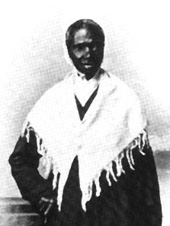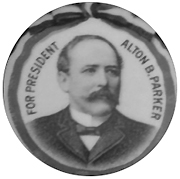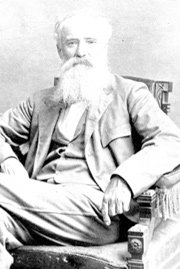Esopus Turns 200
Summer 2011
The colorful and inspirational individuals who lived in, and often shaped, the Town of Esopus over the past two hundred years have included a former slave, ship captains, millionaires, preachers, a presidential candidate, a world-renown naturalist, world-shaping entrepreneurs, a world-famous walker, and many philanthropists. Below are a few.
Truth
 Today, the Town of Esopus village of Port Ewen has a pocket park awaiting a statue of its namesake, Sojourner Truth. Truth was born Isabella (1797) a slave, in Swartekill, Ulster County, now part of the Town of Esopus. Eventually she walked away from the “owner’s” farm and was taken in by Isaac and Maria Van Wagenen who apparently treated her much better while they waited for the NYS law outlawing slavery.
Today, the Town of Esopus village of Port Ewen has a pocket park awaiting a statue of its namesake, Sojourner Truth. Truth was born Isabella (1797) a slave, in Swartekill, Ulster County, now part of the Town of Esopus. Eventually she walked away from the “owner’s” farm and was taken in by Isaac and Maria Van Wagenen who apparently treated her much better while they waited for the NYS law outlawing slavery.
From 1799 New York had been gradually legislating the abolition of slave ownership which was to happen July 4, 1827.
Isabella, who changed her name to Sojourner Truth in 1843 after a religious awakening, grew in fame when she began preaching and then challenged the legality of the sale of her son by appearing before a judge at the Kingston, NY court house to plead her case.
Today, every list of women who changed the world includes “Sojourner Truth.”
Justice
 Judge Alton B. Parker was born in Cortland, NY. He became a lawyer by attending Albany Law School, clerking (1872) for the Schoonmaker and Hardenberg firm in Kingston and then taking the bar exam. He was a successful attorney and marrying Schoonmaker’s daughter may have helped, too. Parker ran for President of the United States in 1904 opposing Teddy Roosevelt. Parker seemed to think that tromping around the country was beneath the dignity of a candidate for US President, so he stayed home at West Park with his dignity intact, and lost. He returned to the practice of law and became the Chief Judge of the NYS Court of Appeals, the highest judgeship in the state.
Judge Alton B. Parker was born in Cortland, NY. He became a lawyer by attending Albany Law School, clerking (1872) for the Schoonmaker and Hardenberg firm in Kingston and then taking the bar exam. He was a successful attorney and marrying Schoonmaker’s daughter may have helped, too. Parker ran for President of the United States in 1904 opposing Teddy Roosevelt. Parker seemed to think that tromping around the country was beneath the dignity of a candidate for US President, so he stayed home at West Park with his dignity intact, and lost. He returned to the practice of law and became the Chief Judge of the NYS Court of Appeals, the highest judgeship in the state.
The American Way
Nothing says America like a rags to fame (if not ultimate riches) story. That would sum up the lives of Edward Payson Weston* and John Burroughs.*
 Weston, a self-promoter with style and guile, turned the loss of a friendly wager on the presidential election of 1860 into his life’s work.
Weston, a self-promoter with style and guile, turned the loss of a friendly wager on the presidential election of 1860 into his life’s work.
When Abraham Lincoln won, Weston lost his bet and had to walk from Boston to Washington, DC and attend the inauguration ceremony.
Legend (and Weston’s biography) tells us Lincoln heard about the youngster’s walk, met him, and offered to pay his train fare back to Boston (after all, it was March!). Weston declined, walked home and from then on made his way in the world to become a “superhero” of his day by walking across countries and continents in record-setting times. This was a competitive sport in those days and he made money through sponsors—manufacturers of foods, medicines, shoes, socks, etc.
Weston retired to what became Weston Road in Esopus with his family, but left under very strange circumstances*, then lived in NYC where he was hit by a taxi, confined to a wheelchair, and eventually died penniless at 94.
 John Burroughs was born in Roxbury, NY, and schooled with friend John Jay Gould in the Roxbury one-room bastion of learning.
John Burroughs was born in Roxbury, NY, and schooled with friend John Jay Gould in the Roxbury one-room bastion of learning.
Both boys went on to great things, but Burroughs settled in West Park, wrote at Slabsides and raised his son, Julien at Riverby, their home on the Hudson. Burroughs’ writings on nature captured the era’s passion for the great outdoors.
Burroughs is the Esopus resident who left the most tangible legacy for us today. His cabin, Slabsides, is a must visit for all nature lovers, his books—simple and clearly written with love—are must reads, and the peaceful Sanctuary, (given to us by those who admired him including Henry Ford), is one of the loveliest, easy-access parks in Esopus.
It is amusing to speculate on who might be the subjects of a small essay like this for Esopus’ tercentennial celebration. Topping these four will not be an easy task.
*On our website, www.abouttown.us, you will find stories on each of these fascinating people. Go to Articles & Stories.
See calendar of events for Esopus Celebration dates, or the Klyne Esopus Museum’s site. Their exhibit for 2011 is “The 200th.”
By Vivian Yess Wadlin with images from her collection.
